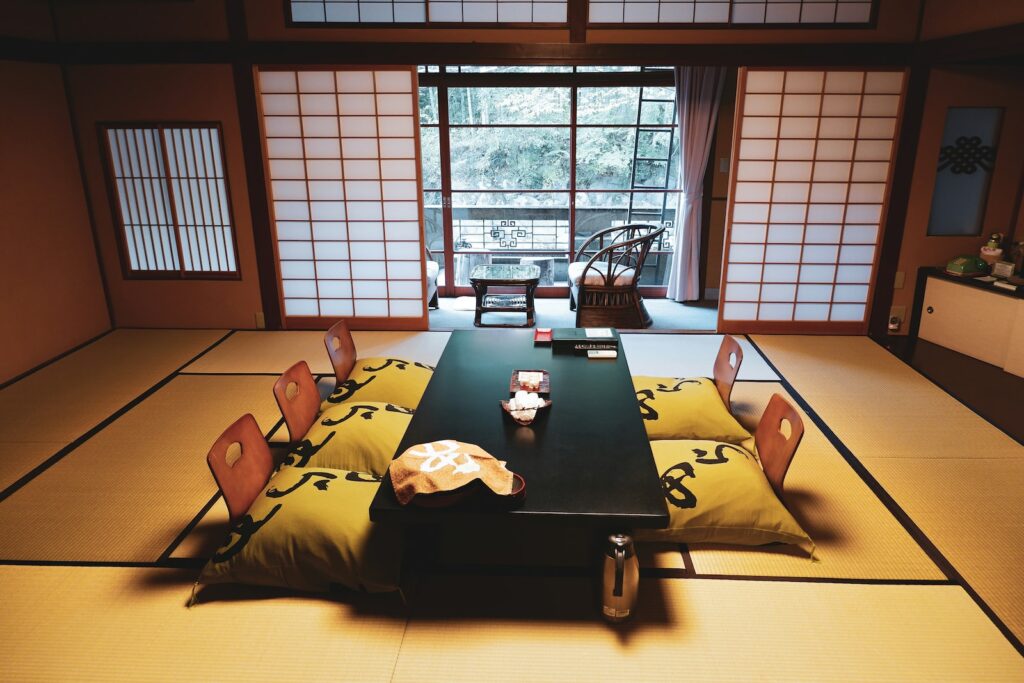What is a futon? A futon is a Japanese-style mattress that can be folded into a sofa. Most come with a mattress that is often much thinner so it can fit into the foldable frame. Some also include cushions to use when it is set up as a couch.
Today, most futon mattresses are similar to standard mattresses with innersprings, a foam filling, or a combination of both. Futons act as both a sofa cushion and a bed, and they are often cheaper than standard beds and sofas.
What Is A Japanese Futon Bed?
Futon mattresses originated in Japan and were kept in the houses of wealthy families in Tokyo. The original futon mattress was typically thinner and meant to be used on the floor. The word futon comes from the Japanese word for “bed,” describing the portable bedding system rather than the mattress itself.

A traditional Japanese futon set comes with a flexible type of mattress, the shikibuton, and a duvet, the kakebuton. In Japan, they are placed on a tatami mat, which is then rolled up every morning. The earliest Japanese futon mattresses were typically filled with hay, reeds, or animal hair.
William Brouwer, a woodworker from Cambridge, Massachusetts, was intrigued by the Japanese futons and created the first futon sofa bed frame in 1982. Since then, it has soared in popularity in the United States and worldwide for its versatility and convenience as an economical and minimalist furniture piece.
How Are Futons Made?
Japanese futon mattresses are typically two to three inches thick and stuffed with cotton, making them pliable enough to roll up during the day. While the craftsmanship involved has enabled them to have a lifespan of around fifteen years – making them much longer-lasting than your average western mattress – this also means that each part must be carefully made for the sleeper’s comfort and support.
The mattresses are usually filled with cotton and then zipped inside a cotton case. Traditional futons don’t contain synthetic materials, which makes them environmentally friendly compared with other sleeping options; their natural materials are durable and almost always last far longer than their synthetic alternatives. Foam futon mattresses, however, offer great comfort and support yet can be more difficult to store given that they do not roll up as easily as those filled with cotton.
What Is A Futon Mattress Made of?
Every futon comes in three main elements: the mattress, frame, and cover. Futon mattresses are typically made of polyester or cotton on the outside. The futon mattress filling needs to be flexible, so many mattresses often use foam or memory foam, and the frame is often made out of metal or wood slats that can easily bear the weight.

Futon Mattress Material
The best mattress material depends on your bed preference.
Cotton fabric is the most affordable and, therefore, the most common material for futon mattresses. Most futon mattresses use 100% cotton, which creates a firmer sleeping surface. Organic cotton is safer than conventional cotton but will often be more expensive.
Memory foam is soft and perfect for those wanting a mattress that will conform to their bodies. It is the best mattress type to relieve back pain or neck pain. However, it is not the best material when configured as a sofa because of its softness.
Another type of mattress material is innersprings. This coil design is often combined with cotton or has a thin layer of memory foam to provide cushion. Individually wrapped coils provide an even balance when you lay on the mattress, while a springboard type of design creates more bounce. However, leaving it in the sofa position for too long can make the springboard stick.
Frames
There are three basic types of futon frames: loveseat, bifold, and trifold. The loveseat futon frame is a 2-piece mattress created for small spaces. It pulls out into a full or twin-size bed.
The bi-fold frame is the most common type of futon. It folds in half the long way. All you need to do is pull out the bottom part to extend the frame into a bed. Bi-fold futon frames come in queen, full, and smaller sizes.
The trifold frame folds into thirds. However, it requires a thinner mattress because of the way it folds. It can be a little more challenging to convert into a bed or couch because of its somewhat more complex design. Like the bifold, the trifold frame comes in queen, full, and smaller sizes.
Western Futons
In recent decades, futons have become increasingly popular in North America, where they are considered a staple of college dormitories and inexpensive furniture. The construction method used for these contemporary Western-style futons is similar to that of Japanese traditional models: the batting is covered with cotton or a synthetic fabric such as polyester.

However, these Western-style futons differ considerably from their Japanese counterparts. While traditional Japanese-style futons are able to fold double and be stowed easily in a cupboard due to their thin mattresses, Western-style futons typically resemble low wooden sofas and have mattress dimensions more akin to standard western mattresses. They are also more often set up and stored on a steel frame with thin suspension wires for added comfort, unlike traditional Japanese floor mattresses which usually lay directly on tatami matting or tatami floor.
Futon Firmness Level
Futons are usually firmer than conventional mattresses depending on the materials used to construct them. The type of frame also affects how firm the mattress feels.
Foam and memory foam futon mattress is the firmest options. However, memory foam does a better job of conforming to your body as you sleep. On the other hand, futon mattresses that use coil can either be softer or firmer depending on the tension.
Are Futon Mattresses Good for Your Back?
Foam or polyester futon mattresses provide good support for your back and reduce back pain. If you put a futon mattress on the floor, it can potentially provide even better support for your back. However, cheaper futons may not offer as much support as ones made with more high-quality material.

However, futons are not ideal for those with chronic or severe back pain. Other mattresses may provide better support by conforming to your body better. You can also put an extra layer of mattress topper on top of your futon to make it feel more comfortable.
How To Set Up A Futon
Futons are a great way to save space, as they can be used both as a bed and as seating during the day. But laying out your futon can be a bit of an art, so here’s a quick guide to help you get started:
First, lay your futon out on your preferred flooring – it goes without saying that tatami mats are ideal, but any soft surface, such as carpet or mat will do. Then place your pillow and comforter on top, and you have your futon! Note that during the day if you have the room for it then you should roll up your futon – this also means that before buying one it may be worth considering where exactly you’re going to store it. A closet space will suffice.
If there’s nowhere convenient to store the futon then simply placing it in the corner of the room still frees up plenty of space. Finally, if you don’t want to keep rolling up and packing away your futon every day (especially if storage space is an issue) then purchasing a slightly raised wooden frame will remove the need for a tatami mat and also make sure the futon mattress has good air circulation. With these tips in mind you’re sure to get years of comfortable use out of your new futon!
Benefits of a Futon Mattress
A futon mattress can be a perfect choice for those who do not have much square footage to spare. There are several other benefits to bringing a futon into your home.
Versatility

Futons are a versatile piece of furniture to have in your home as a bed and a couch. They are a perfect choice for guests staying overnight or saving room in compact spaces. Unlike a sleeper sofa, a futon takes less effort to transform from one mode to another. It also takes up much less space.
Affordable Price
Typically, futon mattresses are less expensive compared to traditional beds and couches. Higher-quality futons can become pricey, but the average price value for a reliable futon comes at a better deal than the sofa equivalent.
Easy Assemblage
Despite requiring assembly, futon mattresses are easy to put together. They come with clear instructions to assemble and disassemble with minimal work needed to set up the frame.
Are Futons Environmentally Friendly?
When it comes to environmentally friendly furnishing options, a futon may be one of the best choices out there. The highest quality futons do not use synthetic materials in any part of their construction. Instead, each part is made from 100% cotton – the mattress core is pure cotton batting, and the frame is typically constructed with solid hardwood. The ability to choose natural materials makes a futon an eco-friendly choice compared with other sleeping options, particularly when you consider how long-lasting and durable these materials are.
At the end of a futon’s long life, cotton will naturally decompose so it can give back to nature’s cycle – unlike polyester and foam bedding, which will remain in landfills for centuries! Additionally, when purchasing your futon mattress or frame, look for eco-friendly product certifications verifying that sustainable or environmentally conscious practices have been observed throughout its production.
How Long Does A Futon Mattress Last?
Typically, futon mattresses last around five to 10 years. However, the lifespan of durability for a futon mattress depends on its quality and how you use it. If the futon is used solely as a guest bed, it can last for more than ten years. However, if you use it regularly as the main bed or couch, then it will wear out much faster, lasting for about five years.
Caring for Your Futon Mattress
Futon mattresses need a little more maintenance and care than regular box spring mattresses. Moisture is the biggest culprit that can damage the fibers of your mattress and lead to an uncomfortable sleeping surface. It needs to be released periodically since moisture naturally collects while we sleep.
Moisture building over time can also lead to dust mites and the possible growth of mildew. A mattress pad or cover can act as a moisture barrier to ensure a longer lifespan for your futon mattress. Here are a few tips to help protect your futon mattress over time:
- Air out your mattress
- Use a barrier cover or mattress pad to protect it from moisture
- Allow proper air circulation
- Flip your futon mattress often
- Leave your futon mattress in some sunlight
How to Clean Your Futon
Cleaning futon is an important part of maintaining their longevity, as it keeps them fresh, clean, and dust-free. Unlike a traditional mattress, you can’t use a vacuum cleaner to clean a futon mattress. To keep your futon free from dust, it’s best to air them out on a regular basis.
Hang your futon over a balcony or a rack in a well-ventilated area at least once every month, depending on how often you use the futon. This will help keep mold and mildew from forming. If you don’t have access to an outdoor space for airing out your futon, invest in one of the many handheld lotion cleaners now available on Amazon – these are designed specifically for mattresses, so check the labels carefully before making any purchases.
Alternatively, if you prefer using traditional methods then beat the futon lightly with a tataki – which is similar to a carpet beater – every few months to remove dust mites and other allergens. For those who prefer the convenience of modern technology, an anti-dust mite or anti-allergy mattress dryer will help keep away all kinds of pollutants such as dust mites, mold and mildew.
How to Find the Best Futon Mattress
There are a few things to look for when choosing the best futon mattress to get a good night’s sleep.
Thickness

There are two options for futon thickness: either six inches or eight. Thicker mattresses are more comfortable and often more expensive. For those who expect to use their futon as a bed more than a couch, it may be a worthy investment to make.
However, if you plan to use your futon as a sofa more than a bed, you may not need to worry about thickness.
Frame
The most crucial aspect of any frame is its durability. If you are buying a futon for the first time, you will most likely need to buy a frame for your mattress. Most futons come in a tri-fold futon frame with a full or queen-sized bed.
Futon frames are made of either wood or metal. With both, make sure to check the slats to see if they are evenly distributed. They should be at least two and a half to three inches wide to provide adequate support.
When looking at metal frames, make sure the welding looks and feels solid and with well-connected pieces. For wooden futon frames, look for ones made out of hardwoods, like birch, ash, and maple. They have a longer lifespan and generally look more refined as a futon frame with lovely grain patterns.
Warranties
Any good-quality mattress should come with a warranty. Having a trial period allows you to test it out safely, ensuring you receive the product you want. If possible, look for mattresses that come with a warranty so you don’t get locked into restless nights on a futon you don’t like.
Futon Accessories
When considering what accessories you need to accessorize and complete your futon set up, it’s important to keep the traditional Japanese sleeping system in mind. As we mentioned earlier, the word futon in Japanese technically refers to a complete bedding system consisting of a floor mattress, futon sheet, comforter, and pillow.

If you intend to leave a futon out permanently, then you might consider adding some additional cushions that you can use during the day such as an Ojami Zabuton Cushion from Kyoto’s finest zabuton maker, Takaokaya. The rectangular cushion comes with four removable legs and has numerous benefits. Not only does the cushion create a more inviting daytime seating option for the futon mattress, but it also provides extra support for those who enjoy meditating or yoga on their mattress.
The height and firmness of the ojami cushion makes it a perfect accessory for sitting or meditating on your futon mattress. Its elegant material and color options including light blond bamboo tatami mat weave or black polyester canvas blend print design variant make this much-needed accent piece thoroughly modern yet delicately traditional at once—an ideal finishing touch to any low level bedding arrangement!
FAQs
What does a futon bed look like?
A futon bed is a type of furniture usually consisting of several pieces: a low wooden frame, a mattress that can be folded in three pieces (base, back, and legs), and a set of comforters and pillows. Most are made out of wood or metal and may come with optional storage drawers. The mattress generally is made from synthetic materials or cotton and comes in many colors and patterns.
Conclusion
So, what is a futon mattress? There are several reasons why futon mattresses can benefit your space. Not only are they comfortable and versatile, but they also make the most of living spaces and come cheaper than conventional mattresses. They can also work as a convenient guest bed for occasional guests.
If you’re looking to get a good night’s sleep, investing in a high-quality futon mattress can make all the difference.
Article Sources
- Sakaguchi, M., Inouye, S., Yoshizawa, S., et al., (1991). Evaluation of different treatments of Japanese bed quilts for reducing mite allergens. Arerugi=[Allergy], 40(4):439-443. https://europepmc.org/article/med/1854256
- Bergholdt, K., Fabricius, R. N., & Bendix, T. (2008, April 1). Better backs by better beds? Spine 33(7):703-708. https://journals.lww.com/spinejournal/Abstract/2008/04010/Better_Backs_by_Better_Beds_.2.aspx
- Sukigara, S., Yokura, H. and Niwa, M. (1994), “Non‐recovery of Futon Padding after Repeated Compression”, International Journal of Clothing Science and Technology, 6(2/3):51-56. https://www.emerald.com/insight/content/doi/10.1108/09556229410063558/full/html
- McCall, W. V., Boggs, N., & Letton, A. (2012). Changes in sleep and wake in response to different sleeping surfaces: a pilot study. Applied ergonomics, 43(2):386-391. https://www.sciencedirect.com/science/article/abs/pii/S0003687011000858
- Low, F. Z., Chua, M. C., Lim, P. Y., et al., (2017). Effects of Mattress Material on Body Pressure Profiles in Different Sleeping Postures. Journal of chiropractic medicine, 16(1):1–9. https://pubmed.ncbi.nlm.nih.gov/28228692/






